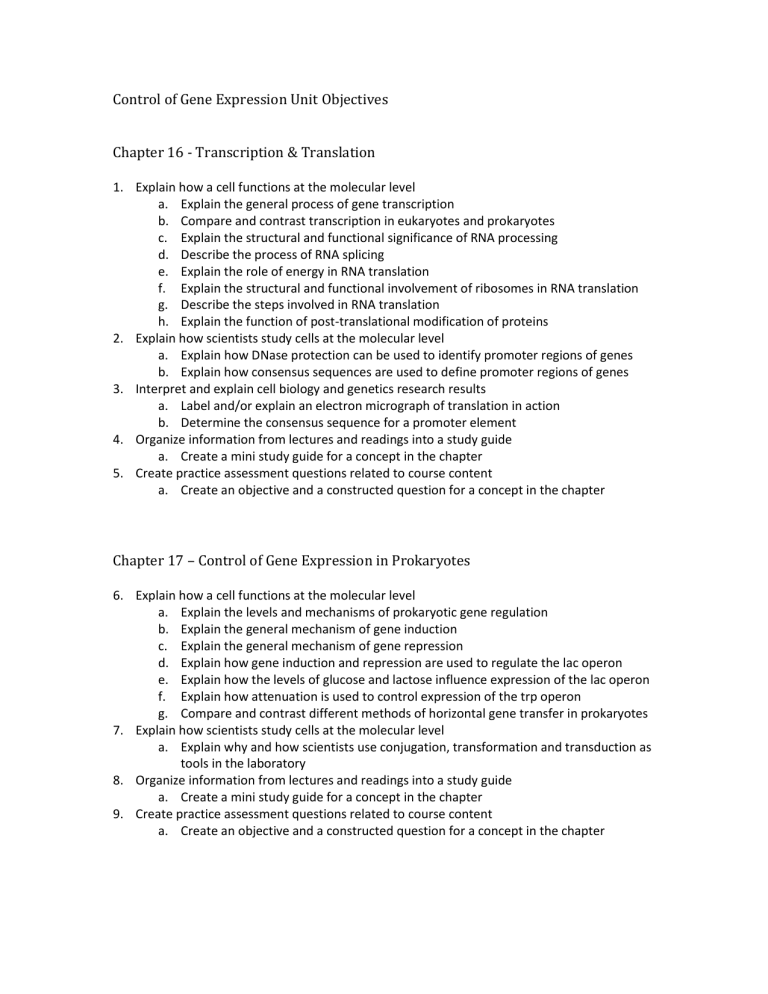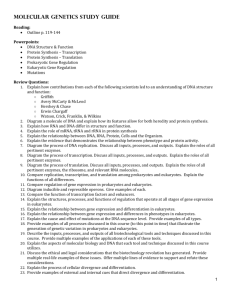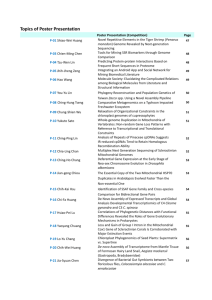Objectives - the Biology Scholars Program Wiki

Control of Gene Expression Unit Objectives
Chapter 16 - Transcription & Translation
1.
Explain how a cell functions at the molecular level a.
Explain the general process of gene transcription b.
Compare and contrast transcription in eukaryotes and prokaryotes c.
Explain the structural and functional significance of RNA processing d.
Describe the process of RNA splicing e.
Explain the role of energy in RNA translation f.
Explain the structural and functional involvement of ribosomes in RNA translation g.
Describe the steps involved in RNA translation h.
Explain the function of post-translational modification of proteins
2.
Explain how scientists study cells at the molecular level a.
Explain how DNase protection can be used to identify promoter regions of genes b.
Explain how consensus sequences are used to define promoter regions of genes
3.
Interpret and explain cell biology and genetics research results a.
Label and/or explain an electron micrograph of translation in action b.
Determine the consensus sequence for a promoter element
4.
Organize information from lectures and readings into a study guide a.
Create a mini study guide for a concept in the chapter
5.
Create practice assessment questions related to course content a.
Create an objective and a constructed question for a concept in the chapter
Chapter 17 – Control of Gene Expression in Prokaryotes
6.
Explain how a cell functions at the molecular level a.
Explain the levels and mechanisms of prokaryotic gene regulation b.
Explain the general mechanism of gene induction c.
Explain the general mechanism of gene repression d.
Explain how gene induction and repression are used to regulate the lac operon e.
Explain how the levels of glucose and lactose influence expression of the lac operon f.
Explain how attenuation is used to control expression of the trp operon g.
Compare and contrast different methods of horizontal gene transfer in prokaryotes
7.
Explain how scientists study cells at the molecular level a.
Explain why and how scientists use conjugation, transformation and transduction as tools in the laboratory
8.
Organize information from lectures and readings into a study guide a.
Create a mini study guide for a concept in the chapter
9.
Create practice assessment questions related to course content a.
Create an objective and a constructed question for a concept in the chapter
Chapter 18 – Control of Gene Expression in Eukaryotes
10.
Explain how a cell functions at the molecular level a.
Explain the levels and mechanisms of eukaryotic gene regulation b.
Compare and contrast prokaryotic and eukaryotic gene regulation mechanisms c.
Describe chromatin and nucleosome structure and explain how it is related to gene expression d.
Compare and contrast the initiation of transcription in prokaryotes and eukaryotes e.
Compare and contrast basal transcription factors and regulatory transcription factors f.
Describe the components of the basal transcription machinery g.
Compare and contrast common DNA binding domains h.
Explain the process and function of alternative splicing i.
Explain how mutation of transcription factor genes can promote cancer formation j.
Compare and contrast proto-oncogenes and tumor suppressor genes
11.
Explain how scientists study cells at the molecular level a.
Compare and contrast northern, southern and western blotting methods b.
Explain how northern blotting can be used to identify genomic enhancer sequences
12.
Interpret and explain cell biology and genetics research results a.
Determine the genomic location of an enhancer sequence using northern blot data
13.
Organize information from lectures and readings into a study guide a.
Create a mini study guide for a concept in the chapter
14.
Create practice assessment questions related to course content a.
Create an objective and a constructed question for a concept in the chapter











